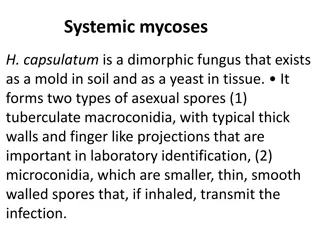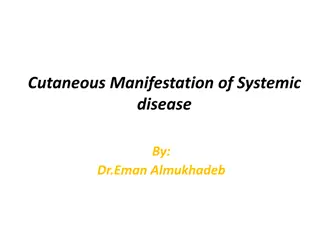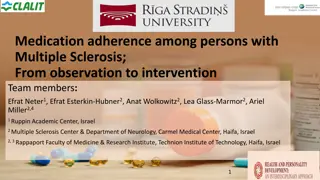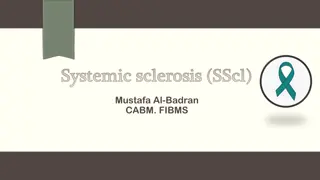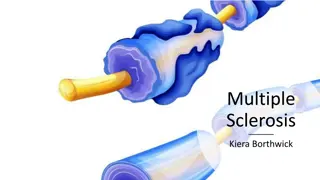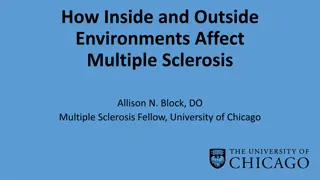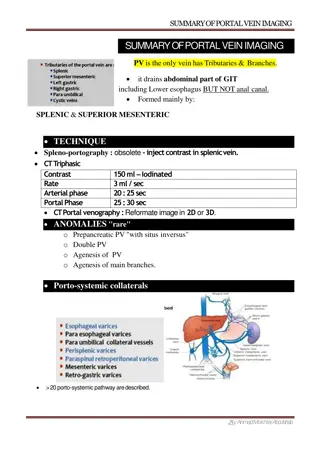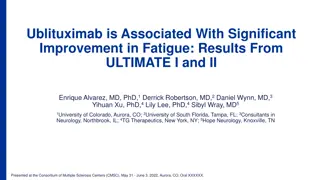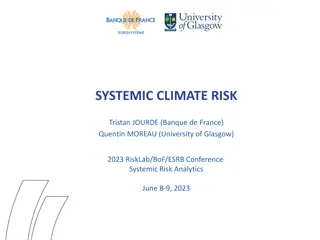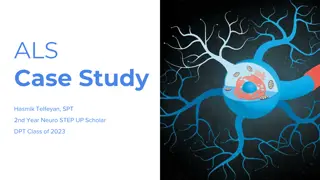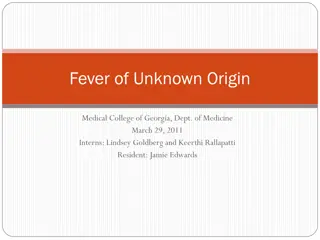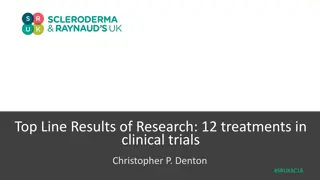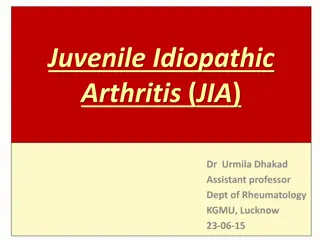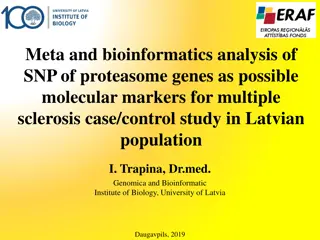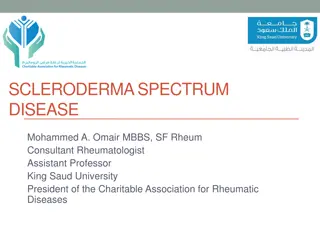Systemic sclerosis
Systemic sclerosis, a connective tissue disease, presents with Raynaud phenomenon and varying clinical subsets. Limited and diffuse forms exhibit distinct features such as musculoskeletal symptoms, pulmonary complications, and specific autoantibodies. Understanding these subsets enhances disease management and prognosis.
Download Presentation

Please find below an Image/Link to download the presentation.
The content on the website is provided AS IS for your information and personal use only. It may not be sold, licensed, or shared on other websites without obtaining consent from the author.If you encounter any issues during the download, it is possible that the publisher has removed the file from their server.
You are allowed to download the files provided on this website for personal or commercial use, subject to the condition that they are used lawfully. All files are the property of their respective owners.
The content on the website is provided AS IS for your information and personal use only. It may not be sold, licensed, or shared on other websites without obtaining consent from the author.
E N D
Presentation Transcript
Systemic sclerosis Eun Bong Lee M.D., Ph.D. Seoul National University College of Medicine 1
52 3, , . , . . # ? 1) 2) 3) 4) 5)
Raynaud phenomenon Definition Exaggerated vascular response to cold temperature, characterized by reversible episodic color change (pallor -> cyanosis -> redness) Causes Connective tissue disease, arterial occlusive disease, medications (beta- blocker, cisplatin), hematologic disease, endocrine disease, occupation (vibration) Treatment Avoidance of cold exposure Calcium channel blocker, PDE5 inhibitors, topical nitrate, angiotensin receptor antagonists, alpha1-adrenergic antagonist, fluoxetine
1 , , . , , , . ? 1) , 2) , 3) , 4) , 5) ,
Clinical subsets of Systemic sclerosis Diffuse Limited
Clinical subsets of Systemic Sclerosis Limited subset Distal, indolent onset Diffuse subset Upto proximal, rapid onset Scleroderma Raynaud phenomenon Precedes fibrosis, often critical ischemia Early arthralgia, fatigue Concomitant with fibrosis Musculoskeletal Severe, arthralgia, carpal tunnel syndrome, tendon friction rubs Frequent, early and severe Pulmonary fibrosis Slow progression, mild Pulmonary arterial hypertension Frequent, late, isolated Secondary to pulmonary fibrosis Scleroderma renal crisis Very rare 15%, early onset Calcinosis cutis Frequent, prominent May occur, mild Autoantibodies Anti-centromere antibody Anti-Scl70 antibody anti-RNA polymerase III antibody
, ? 1) Anti-centromere antibody (+) 2) Anti-Jo 1 antibody (+) 3) Anti-dsDNA antibody (+) 4) Anit-Scl70 antibody (+) 5) Anti-CCP antibody (+)
Autoantibodies in Systemic sclerosis Limited Diffuse Anti-topoisomeraase I (Scl-70) Anticentromere Anti-RNA polymerase III Anti-Th/To Anti-U3RNP Anti-Ku Anti-U1RNP Anti-PMScl Overlap
? 1) (Scleroderma renal crisis) 2) (Interstitial lung disease) 3) (Pulmonary arterial hypertension) 4) (Gastroesophageal reflux) 5) (Pericarditis)
Complication of internal organs 1) Extremities Digital ulceration Arthritis 2) Lung Interstitial lung disease Pulmonary arterial hypertension 3) Heart Pericardial effusion Heart failure 4) Kidney Scleroderma renal crisis 5) Gastrointestinal system Gastroesophageal reflux Gastric antral vascular ectasia Malabsorption
. , . , . X d-dimer . ? FVC (liter) FEV1 (liter) FEV1/FVC(%) 81% DLCO (mL/mmHg/min) 9.5 (45%) 2.76 (80%) 2.24 (85%) 1) (Scleroderma renal crisis) 2) (Interstitial lung disease) 3) (Pulmonary arterial hypertension) 4) (Gastroesophageal reflux) 5) (Pericarditis)
Pulmonary arterial hypertension in systemic sclerosis: diagnosis Pulmonary Capillary Pulmonary vein Right heart catheterization Mean pulmonary artery pressure (PAP) 25 mmHg Pulmonary capillary wedge pressure < 15mmHg Pulmonary artery Pulmonary function test Mild abnormality with low DLCO
. . 1) 2) 3) 4) 5)
Pulmonary arterial hypertension in systemic sclerosis: treatment Prostaglandin pathway Endothelin pathway NO pathway Arachidonic acid Big endothelin Arginine Endothelin converting enzyme NO Prostacyclin synthase synthase ET-1 NO Prostacyclin Endothelin receptor antagonists Riociguat cGMP Prostacyclin derivatives cAMP Endothelin receptor A Endothelin receptor B Phosphodiesterase type-5 Phosphodiesterase type-5 inhibitors Examples: Sildenafil Tadalafil Examples: Bosentan Ambrisentan Macitentan Examples: Epoprostenol Treprostinil Iloprost
. 190 mmHg/120 mmHg , 100/ , 20/ , 36.5 C . . ? 5,600/ul, 10.0 g/dL, 250x 103/ul BUN 50 mg/dL, Cr 4.0 mg/dL 1) 2) 3) 4) 5)
Scleroderma renal crisis Risk groups African American, male Diffuse cutaneous type AntiRNA polymerase III antibody Use of High dose glucocorticoid Manifestations Hypertension Oliguric renal insufficiency Proteinuria/hematuria Thrombocytopenia, MAHA Treatment ACE inhibitors (e.g. captopril, enalarpril)
Take-home message Rayanaud phenomenon Clinical subsets (Diffuse vs Limited) Autoantibodies anti-centromere antibody anti-topoisomerase I antibody anti-RNP polymerase antibody Internal organ involvement and treatment



